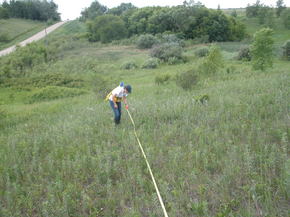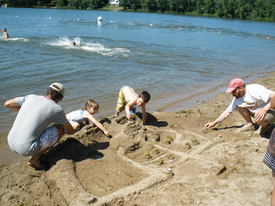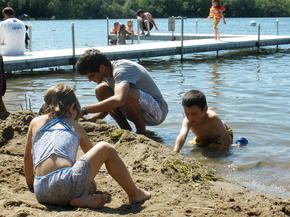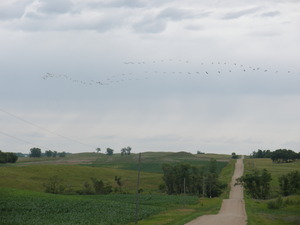|
|
Ech jenkins FNC protocol revised.doc
Ech Guide to Co-Fl Sp.xls
I have a photo guide but I can’t upload it b/c the file is too large.
If you plan on helping with FNC, please read the documents above. It’s important that everyone counts inflorescences the same way. Thanks!
Also, for tomorrow, there are a couple of notes I thought I’d add:
>Please make a note if you see ants on the head of the plant you are observing.
>Also make a note if it is mostly cloudy.
>Try to get to your site with about 10 min to spare so you can get your supplies ready and orient yourself with the placement of the flags to avoid time spent wandering in search of flags.
>Please try to start your observation as close to 8am as possible. End at 11am. Do not start an observation if you can’t finish by 11.
>Remember that you will only be collecting styles at the end of the observation pd from now on. Clean your tweezers with your shirt in between collections.
Thank you thank you thank you to everyone for helping this week. Just in terms of my project, we characterized floral neighborhoods for almost 70 plants in three days. In terms of pollinator observations, Tuesday’s escapades in the remnants were fruitful, but thursday’s weather would not hold out for us, so we had to postpone the second day of observations to next week, meaning we will have to randomly select a different set of 8 plants for all 10 remnants. I expect to see some more diversity in the neighborhoods next week because some species are just starting to flower like Coreopsis, Dalia, Apocynum, and Amorpha.
Here;s Amanda measuring to the nearest flowering Echinacea in Aanenson’s:

Here’s some pictures of our fun 4th of July and the amazing sustainable sandcastle.

Waniel, Per, and Hattie

Yesterday Daniel told us we could have a romantic walk in Staffanson Prairie if we came with him, but instead he made kate and I search his and Amy’s transects. What a trickster. Here he is cursing the heavens.

A flock of pelicans flew overhead at NWLF.

I have many more pictures http://picasaweb.google.com/mimijenkins/MinnesotaSummer09# in case you’re interested.
Hey everyone,
Thanks again for collecting helping with style collection, so far I’ve made four slides and the results are certainly interesting. There is certainly more pollen from 8am to 11am, but it’s going to be hard to tell what pollen is there. So far, I haven’t seen any thistle pollen, which is purplish, or any football shaped pollen, only a Echinacea and/or “-opsis” pollen (Heliopsis or Coriopsis). But then, my current sample size is tiny, so this may change. I have a lot more slides to produce, but so far so good!
FOR NEXT WEEK:
The protocol for style collection next week is a bit different, so please read this and take any notes that you feel are necessary, or ask me any questions you might have.
We will only be collecting styles at the end of the observation period. ONLY COLLECT STYLES ONCE!
Prior to taking the style off the plant, we will be recording style persistence data, to recap:
The form will have five new lines for you to fill out, fr1, fr2, mr1, mr2, and immatures.
Fr1 will be the lower row of unshriveled styles. Count a row if there are more that 3/4 of the styles left.
Fr2 will be the upper row (ie the most recent) row of unshriveled styles.
Mr1 will be the first row of male anthers
Mr2 will be the last row of male anthers (usually there will not be a mr2, so leave this blank)
Immatures is the number of rows or florets left (put an “r” or an “f” to indicate which). Only count florets if there are 11 or less. Only do this if head is at the end of flowering.
One last thing, if there is still a problem with recording the letter field, enter the tag number of the plant in that space and enter the flag letter in the notes (if there is no tag, put a zero). There shouldn’t be a problem, but if there is, just try to capture the information requested in the notes section.
Thanks again for your help and your patience!
-Kate Monster
This may (tentatively) be the official web presence of the pollen library – I am fairly comfortable using wikispaces and the students in my classes are as well. See if it works and provide any feedback you may have.
pollen.wikispaces.com
Enjoy the weekend.
For those who may find it useful soon. The ppt file (which is large) contains the partial identification key for our usage.
If you look closely, the diameters of the main four (Amanda has found) at this time are marked.
More to come next week.Who’s who.ppt
The Protocol for Style collection tomorrow is a bit different, so, everyone needs to get to the farm at 7:15 so we can go over it! But let me give you a quick overview of the main points:
• We will only be collecting styles at the end of the observation period. ONLY COLLECT STYLES ONCE!
• Prior to taking the style off the plant, we will be recording style persistence data:
o The form will have five new lines for you to fill out: fr1, fr2, mr1, mr2, and immatures:
ß Fr1 will be the first row of unshriveled styles. Count a row if there are any left at all.
ß Fr2 will be the last row (ie the most recent) row of unshriveled styles.
ß Mr1 will be the first row of male anthers
ß Mr2 will be the last row of male anthers (usually mr1 and mr2 are the same thing, ie the same row so just fill in the same number twice if this is the case)
ß Immatures is the number of rows with immature florets left, or if the number is less than 11 total (for the whole head), put that number down.
We’ll go over this quickly tomorrow so everyone can get the idea.
• One last thing, if there is still a problem with recording the letter field, enter the tag number of the plant in that space and enter the flag letter in the notes (if there is no tag, put a zero). There shouldn’t be a problem, but if there is, just try to capture the information requested in the notes section.
Thanks again for your help and your patience!
-Kate Monster
Yesterday, between ten people at ten remnants, we collected…
68 pollinators!!
(That’s almost 70!)
A big thanks to all who participated. You had an impressive capture rate and recorded your vials flawlessly.
We will go out to collect again tomorrow morning, each person to a different randomly chosen site (I will post these on the flog later today). Please arrive at Hjelm House at 7:30 to synch visors and pick up supplies so that we can all begin observations at 8:00 AM. I will provide muffins and coffee.
Here are some updates to the pollinator collection protocol– please read them and jot them down (if necessary) on your printed protocol before going out tomorrow morning.
1) As you all noticed, the visor option for “pollinator observed” does not allow you to move on unless you provide a response. There are two methods for selecting either “yes” or “no”. What I would prefer that you do is click on the words “pollinator observed” and click either “yes” or “no” on the resulting screen. The other possible method is to check the box for “yes” or check and un-check the box for “no”, but this should only serve as a backup plan.
2) When entering your stopwatch time, please use a decimal between minutes and seconds. So, if it takes six minutes and twenty seconds for a pollinator to arrive, your entry should read “6.20”.
3) If you observe but do not capture a pollinator, enter the data for the observation, select “no” for “pollinator captured?” and move on to the next plant. Do not stay at that plant to wait for more pollinators.
If you have any other questions or helpful tips for tomorrow’s collection crew please write them in the comments and we will address them before tomorrow morning.
Thanks again, guys– I guess dreams really do come true.
I have returned to take images of pollen as seen below. It will still be a few hours/days/more? to get the images as desired but this is a start. I am predicting some trouble to distinguish between coreopsis, helianthus, and echinacea so be ready to be distinguishing.
Attached are a protocol for pollen slides and the image of echinacea 7.1.09.ech7.1
Protocol for Pollen Slide Prep.doc
Amanda, Kate, and I have combined our protocols and I’ve included a revised equipment list.
Echinacea PONS equip list.doc
Ech combined PollComp Protocols.doc
The following people have agreed (I think) to help with this project on the mornings of July 7th and July 9th, as well as July 21st and July 23rd. If you cannot for some reason, let us know tomorrow.
Stuart, Gretel, Caroline, Amy, Daniel, Greg, Megan, Mimi, Amanda, Kate. Thanks everyone!
Also, after some discussion with Allegra about her pollination and painting needs for this week, I think that we need to either A) give up one person and therefore one remnant to help Allegra or B) have the normal 4 observations for remnants with less than 8 plants instead of doing more observations within the 3 hr pd, and have those people help Allegra when they are done early with pollinator observations/style collection or C) a combination of A&B. Thoughts?
Note: I have included the protocol in with pollinator observations and style collections because we are using the same plants for all 3. However, 3 people can do this over the course of 3 pm’s. Those who are helping so far are: Kate, Allegra (when not doing pm pollinations)
Friday we practiced catching insects for a half hour but much more practice is needed and those who were not there on friday need to be trained. I think a group training/practicing session before lift-off is imperative.
Today Daniel and Allegra helped me assess the flowering plants situation at some of the remnants we plan on using. We flagged flowering plants at: Riley (5),YOH (3), NRRX (4), LC (8), Steven’s appch (3). Some of these sites had plants that seemed likely to flower by Tuesday so we flagged those plants as well.We randomly selected 8 plants for LC since there were 17 that were either flowering or seemed very likely to flower by Tuesday. There was only 1 plant flowering at NWLF so that site has been eliminated. We also noted co-flowering species for each remnant. Tomorrow we need to finish flagging and randomly selecting plants at the 5 other remnants.
Stay tuned for July 4th picnic and kick-ass sandcastle pictures!
|
|





